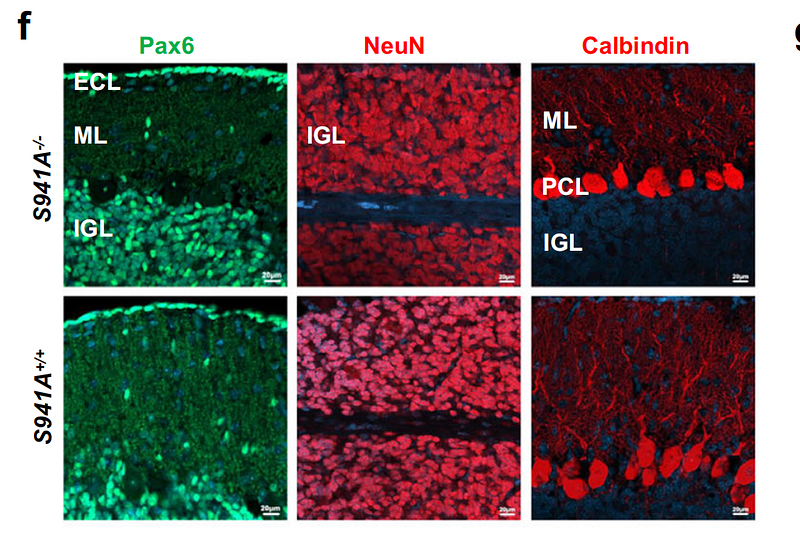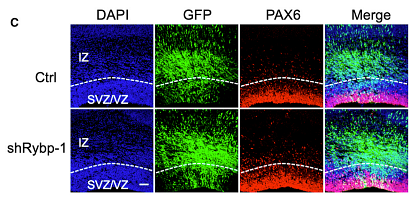PAX6 Recombinant Rabbit Monoclonal Antibody [SD08-31]

Specification
Catalog# ET1612-89
PAX6 Recombinant Rabbit Monoclonal Antibody [SD08-31]
-
WB
-
IF-Cell
-
IF-Tissue
-
IHC-P
-
FC
-
Human
-
Mouse
-
Rat
Overview
Product Name
PAX6 Recombinant Rabbit Monoclonal Antibody [SD08-31]
Antibody Type
Recombinant Rabbit monoclonal Antibody
Immunogen
Recombinant protein within Human PAX6 aa 152-351 / 422.
Species Reactivity
Human, Mouse, Rat
Validated Applications
WB, IF-Cell, IF-Tissue, IHC-P, FC
Molecular Weight
Predicted band size: 47 kDa
Positive Control
HeLa cell lysate, 293T cell lysate, RAW264.7 cell lysate, Mouse cerebellum tissue lysate, Rat cerebellum tissue lysate, human pancreas tissue, mouse cerebellum tissue, rat cerebellum tissue, mouse eyeball tissue, rat eyeball tissue, mouse pancreas tissue, rat pancreas tissue, rat retina tissue, 293T, RAW264.7 .
Conjugation
unconjugated
Clone Number
SD08-31
RRID
Product Features
Form
Liquid
Storage Instructions
Shipped at 4℃. Store at +4℃ short term (1-2 weeks). It is recommended to aliquot into single-use upon delivery. Store at -20℃ long term.
Storage Buffer
1*TBS (pH7.4), 0.05% BSA, 40% Glycerol. Preservative: 0.05% Sodium Azide.
Isotype
IgG
Purification Method
Protein A affinity purified.
Application Dilution
-
WB
-
1:5,000
-
IF-Cell
-
1:50
-
IF-Tissue
-
1:50-1:200
-
IHC-P
-
1:50-1:1,000
-
FC
-
1:1,000
Applications in Publications
Species in Publications
| Mouse | See 2 publications below |
Target
Function
Pax genes contain paired domains with strong homology to genes in Drosophila which are involved in programming early development. Lesions in the Pax-6 gene account for most cases of aniridia, a congenital malformation of the eye, chiefly characterized by iris hypoplasia, which can cause blindness. Pax-6 is involved in other anterior segment malformations besides aniridia, such as Peters anomaly, a major error in the embryonic development of the eye with corneal clouding with variable iridolenticulocorneal adhesions. The Pax-6 gene encodes a transcriptional regulator that recognizes target genes through its paired-type DNA-binding domain. The paired domain is composed of two distinct DNA-binding subdomains, the amino-terminal subdomain and the carboxy-terminal subdomain, which bind respective consensus DNA sequences. The human Pax-6 gene produces two alternatively spliced isoforms that have the distinct structure of the paired domain.
Background References
1. Guye P et al. Genetically engineering self-organization of human pluripotent stem cells into a liver bud-like tissue using Gata6. Nat Commun 7:10243 (2016).
2. Maury Y et al. Combinatorial analysis of developmental cues efficiently converts human pluripotent stem cells into multiple neuronal subtypes. Nat Biotechnol 33:89-96 (2015).
Sequence Similarity
Belongs to the paired homeobox family.
Tissue Specificity
Fetal eye, brain, spinal cord and olfactory epithelium. Isoform 5a is less abundant than the PAX6 shorter form.
Post-translational Modification
Ubiquitinated by TRIM11, leading to ubiquitination and proteasomal degradation.
Subcellular Location
Nucleus.
Synonyms
AN 2 antibody
AN antibody
AN2 antibody
Aniridia type II protein antibody
D11S812E antibody
FVH1 antibody
KIAA0552 antibody
Leucine zipper putative tumor suppressor 3 antibody
LZTS3 antibody
MGC17209 antibody
ExpandAN 2 antibody
AN antibody
AN2 antibody
Aniridia type II protein antibody
D11S812E antibody
FVH1 antibody
KIAA0552 antibody
Leucine zipper putative tumor suppressor 3 antibody
LZTS3 antibody
MGC17209 antibody
MGDA antibody
Oculorhombin antibody
Paired box 6 antibody
Paired box gene 6 (aniridia keratitis) antibody
Paired Box Gene 6 antibody
Paired box homeotic gene 6 antibody
Paired box protein Pax-6 antibody
Paired box protein Pax6 antibody
PAX 6 antibody
PAX6 antibody
PAX6_HUMAN antibody
ProSAP-interacting protein 1 antibody
PROSAPIP1 antibody
Sey antibody
WAGR antibody
CollapseImages
-

☑ Relative expression (RE)
Western blot analysis of PAX6 on different lysates with Rabbit anti-PAX6 antibody (ET1612-89) at 1/5,000 dilution.
Lane 1: HeLa cell lysate
Lane 2: MCF7 cell lysate (negative)
Lane 3: 293T cell lysate
Lane 4: RAW264.7 cell lysate
Lane 5: Mouse cerebellum tissue lysate
Lane 6: Rat cerebellum tissue lysate
Lysates/proteins at 20 µg/Lane.
Predicted band size: 47 kDa
Observed band size: 47 kDa
Exposure time: 30 seconds; ECL: K1801;
4-20% SDS-PAGE gel.
Proteins were transferred to a PVDF membrane and blocked with 5% NFDM/TBST for 1 hour at room temperature. The primary antibody (ET1612-89) at 1/5,000 dilution was used in 5% NFDM/TBST at 4℃ overnight. Goat Anti-Rabbit IgG - HRP Secondary Antibody (HA1001) at 1/50,000 dilution was used for 1 hour at room temperature. -

Immunohistochemical analysis of paraffin-embedded human pancreas tissue with Rabbit anti-PAX6 antibody (ET1612-89) at 1/200 dilution.
The section was pre-treated using heat mediated antigen retrieval with sodium citrate buffer (pH 6.0) (high pressure) for 2 minutes. The tissues were blocked in 1% BSA for 20 minutes at room temperature, washed with ddH2O and PBS, and then probed with the primary antibody (ET1612-89) at 1/200 dilution for 1 hour at room temperature. The detection was performed using an HRP conjugated compact polymer system. DAB was used as the chromogen. Tissues were counterstained with hematoxylin and mounted with DPX. -

Immunohistochemical analysis of paraffin-embedded mouse cerebellum tissue with Rabbit anti-PAX6 antibody (ET1612-89) at 1/1,000 dilution.
The section was pre-treated using heat mediated antigen retrieval with sodium citrate buffer (pH 6.0) (high pressure) for 2 minutes. The tissues were blocked in 1% BSA for 20 minutes at room temperature, washed with ddH2O and PBS, and then probed with the primary antibody (ET1612-89) at 1/1,000 dilution for 1 hour at room temperature. The detection was performed using an HRP conjugated compact polymer system. DAB was used as the chromogen. Tissues were counterstained with hematoxylin and mounted with DPX. -

Immunohistochemical analysis of paraffin-embedded rat cerebellum tissue with Rabbit anti-PAX6 antibody (ET1612-89) at 1/1,000 dilution.
The section was pre-treated using heat mediated antigen retrieval with sodium citrate buffer (pH 6.0) (high pressure) for 2 minutes. The tissues were blocked in 1% BSA for 20 minutes at room temperature, washed with ddH2O and PBS, and then probed with the primary antibody (ET1612-89) at 1/1,000 dilution for 1 hour at room temperature. The detection was performed using an HRP conjugated compact polymer system. DAB was used as the chromogen. Tissues were counterstained with hematoxylin and mounted with DPX. -

Immunohistochemical analysis of paraffin-embedded mouse eyeball tissue using anti-PAX6 antibody. The section was pre-treated using heat mediated antigen retrieval with Tris-EDTA buffer (pH 8.0-8.4) for 20 minutes.The tissues were blocked in 5% BSA for 30 minutes at room temperature, washed with ddH2O and PBS, and then probed with the primary antibody (ET1612-89, 1/50) for 30 minutes at room temperature. The detection was performed using an HRP conjugated compact polymer system. DAB was used as the chromogen. Tissues were counterstained with hematoxylin and mounted with DPX.
-

Immunohistochemical analysis of paraffin-embedded rat eyeball tissue using anti-PAX6 antibody. The section was pre-treated using heat mediated antigen retrieval with Tris-EDTA buffer (pH 8.0-8.4) for 20 minutes.The tissues were blocked in 5% BSA for 30 minutes at room temperature, washed with ddH2O and PBS, and then probed with the primary antibody (ET1612-89, 1/50) for 30 minutes at room temperature. The detection was performed using an HRP conjugated compact polymer system. DAB was used as the chromogen. Tissues were counterstained with hematoxylin and mounted with DPX.
-

Immunohistochemical analysis of paraffin-embedded mouse pancreas tissue using anti-PAX6 antibody. The section was pre-treated using heat mediated antigen retrieval with Tris-EDTA buffer (pH 8.0-8.4) for 20 minutes.The tissues were blocked in 5% BSA for 30 minutes at room temperature, washed with ddH2O and PBS, and then probed with the primary antibody (ET1612-89, 1/50) for 30 minutes at room temperature. The detection was performed using an HRP conjugated compact polymer system. DAB was used as the chromogen. Tissues were counterstained with hematoxylin and mounted with DPX.
-

Immunohistochemical analysis of paraffin-embedded rat pancreas tissue using anti-PAX6 antibody. The section was pre-treated using heat mediated antigen retrieval with Tris-EDTA buffer (pH 8.0-8.4) for 20 minutes.The tissues were blocked in 5% BSA for 30 minutes at room temperature, washed with ddH2O and PBS, and then probed with the primary antibody (ET1612-89, 1/50) for 30 minutes at room temperature. The detection was performed using an HRP conjugated compact polymer system. DAB was used as the chromogen. Tissues were counterstained with hematoxylin and mounted with DPX.
-

Immunohistochemical analysis of paraffin-embedded rat retina tissue with Rabbit anti-PAX6 antibody (ET1612-89) at 1/200 dilution.
The section was pre-treated using heat mediated antigen retrieval with sodium citrate buffer (pH 6.0) (high pressure) for 2 minutes. The tissues were blocked in 1% BSA for 20 minutes at room temperature, washed with ddH2O and PBS, and then probed with the primary antibody (ET1612-89) at 1/200 dilution for 1 hour at room temperature. The detection was performed using an HRP conjugated compact polymer system. DAB was used as the chromogen. Tissues were counterstained with hematoxylin and mounted with DPX. -

Flow cytometric analysis of 293T cells labeling PAX6.
Cells were fixed and permeabilized. Then stained with the primary antibody (ET1612-89, 1/1,000) (red) compared with Rabbit IgG Isotype Control (green). After incubation of the primary antibody at +4℃ for an hour, the cells were stained with a iFluor™ 488 conjugate-Goat anti-Rabbit IgG Secondary antibody (HA1121) at 1/1,000 dilution for 30 minutes at +4℃. Unlabelled sample was used as a control (cells without incubation with primary antibody; black). -

Immunocytochemistry analysis of RAW264.7 cells labeling PAX6 with Rabbit anti-PAX6 antibody (ET1612-89) at 1/50 dilution.
Cells were fixed in 4% paraformaldehyde for 20 minutes at room temperature, permeabilized with 0.1% Triton X-100 in PBS for 5 minutes at room temperature, then blocked with 1% BSA in 10% negative goat serum for 1 hour at room temperature. Cells were then incubated with Rabbit anti-PAX6 antibody (ET1612-89) at 1/50 dilution in 1% BSA in PBST overnight at 4 ℃. Goat Anti-Rabbit IgG H&L (iFluor™ 488, HA1121) was used as the secondary antibody at 1/1,000 dilution. PBS instead of the primary antibody was used as the secondary antibody only control. Nuclear DNA was labelled in blue with DAPI.
Beta tubulin (M1305-2, red) was stained at 1/100 dilution overnight at +4℃. Goat Anti-Mouse IgG H&L (iFluor™ 594, HA1126) was used as the secondary antibody at 1/1,000 dilution. -

Flow cytometric analysis of RAW264.7 cells labeling PAX6.
Cells were fixed and permeabilized. Then stained with the primary antibody (ET1612-89, 1μg/mL) (red) compared with Rabbit IgG Isotype Control (green). After incubation of the primary antibody at +4℃ for an hour, the cells were stained with a iFluor™ 488 conjugate-Goat anti-Rabbit IgG Secondary antibody (HA1121) at 1/1,000 dilution for 30 minutes at +4℃. Unlabelled sample was used as a control (cells without incubation with primary antibody; black).
Please note: All products are "FOR RESEARCH USE ONLY AND ARE NOT INTENDED FOR DIAGNOSTIC OR THERAPEUTIC USE"
Citation
-
Phosphorylation of human glioma-associated oncogene 1 on Ser937 regulates Sonic Hedgehog signaling in medulloblastoma
Author: Zeng Ling-Hui, Tang Chao, Yao Minli, He Qiangqiang, Qv Meiyu, Ren Qianlei, Xu Yana, Shen Tingyu, Gu Weizhong, Xu Chengyun, Zou Chaochun, Ji Xing, Wu Ximei, Wang Jirong
PMID: 38307877

Journal: Nature Communications
Application:
Reactivity:
Publish date: 2024 Feb
-
Citation
-
FUT8 Regulates Cerebellar Neurogenesis and Development Through Maintaining the Level of Neural Cell Adhesion Molecule Cntn2
Author: Kaiyan Wei,et al
PMID: 39604780
Journal: Molecular Neurobiology
Application: WB
Reactivity: Mouse
Publish date: 2024 Dec
-
Citation
-
RYBP modulates embryonic neurogenesis involving the Notch signaling pathway in a PRC1-independent pattern
Author:
PMID: 34798064

Journal: Stem Cell Reports
Application: IF
Reactivity: Mouse
Publish date: 2021 Dec
-
Citation
Products with the same target and pathway
PAX6 Recombinant Rabbit Monoclonal Antibody [SD081-03]
Application: WB,IHC-P,FC,mIHC,IF-Cell,IF-Tissue,IHC-Fr
Reactivity: Human,Mouse,Rat
Conjugate: unconjugated


